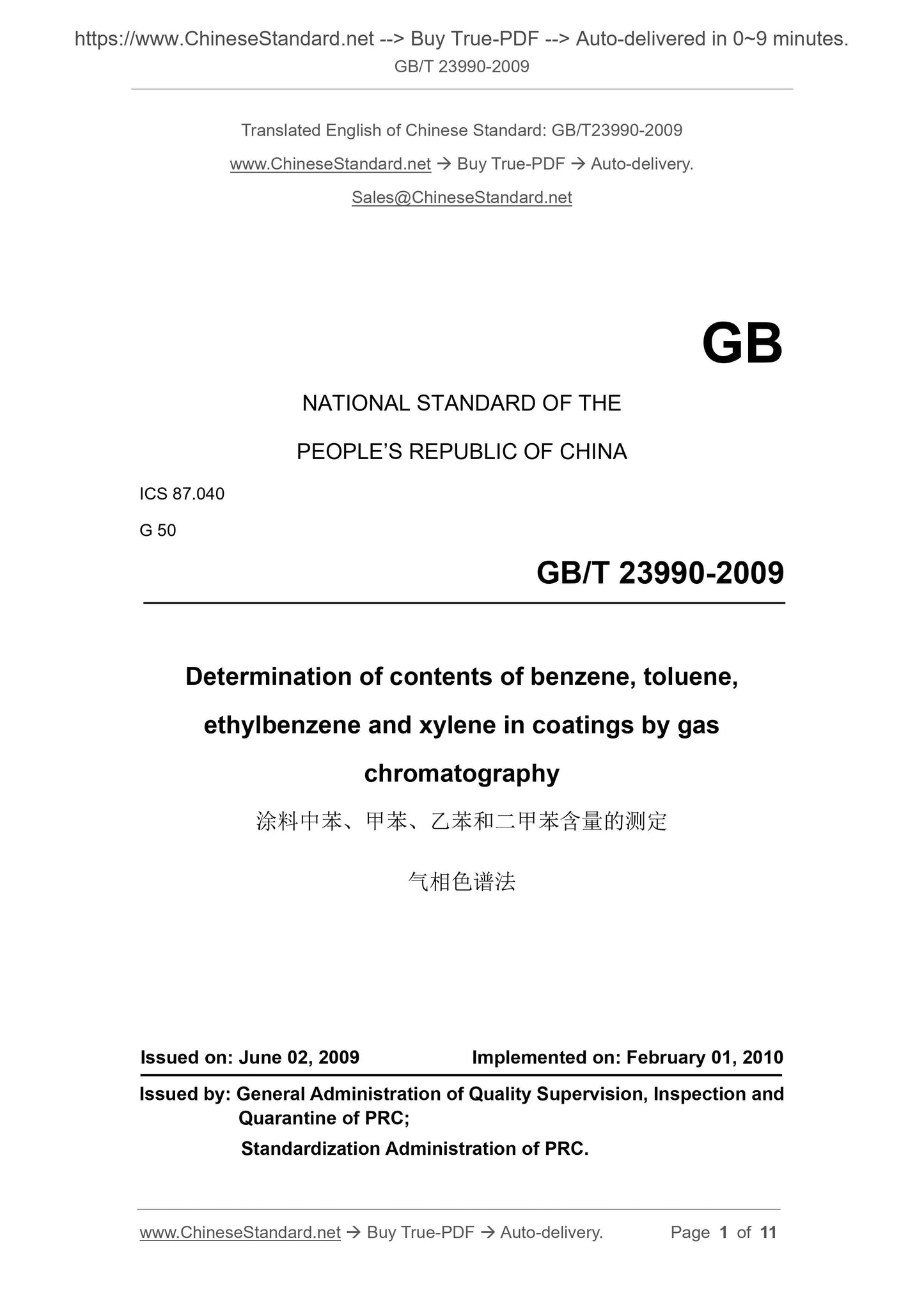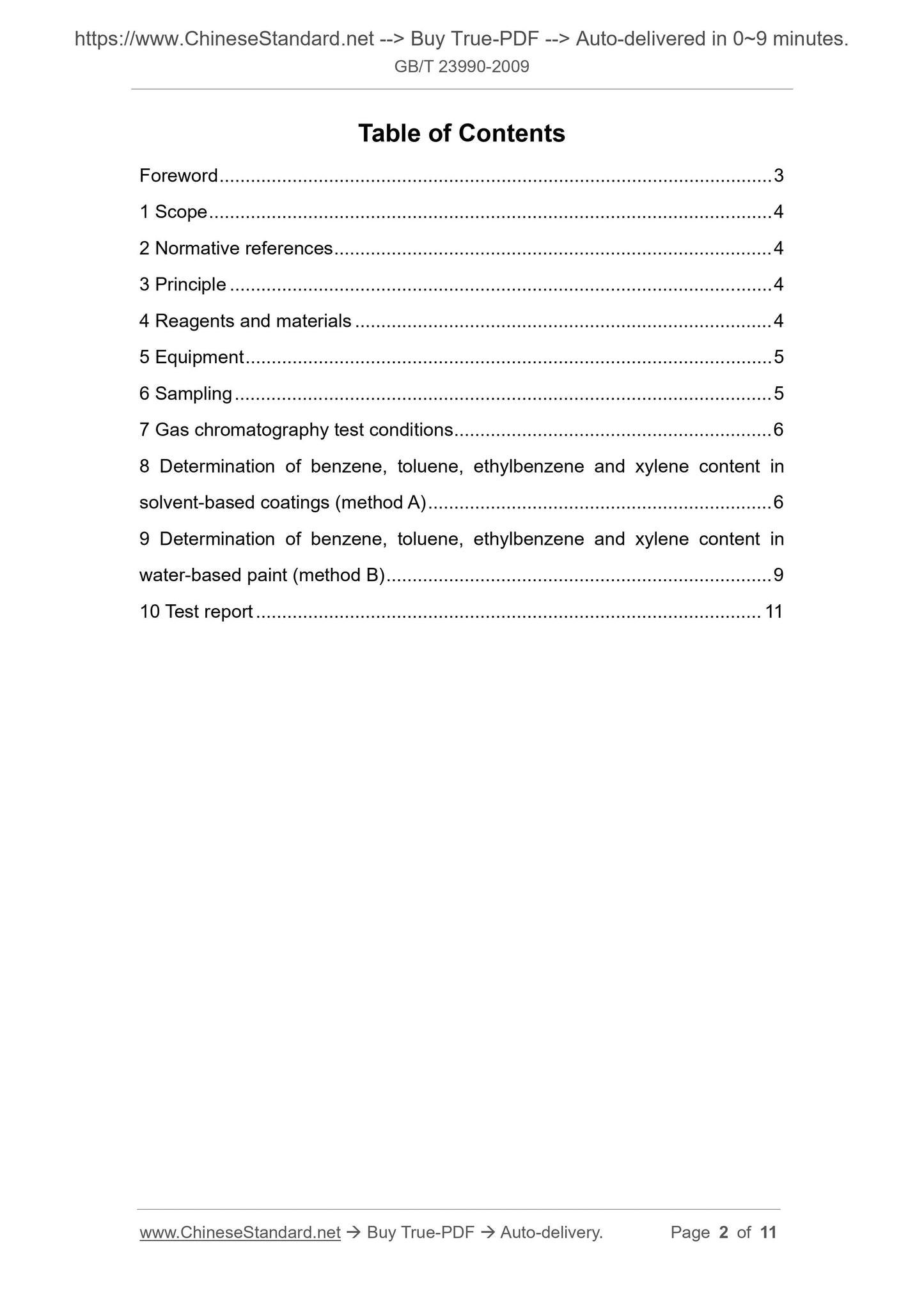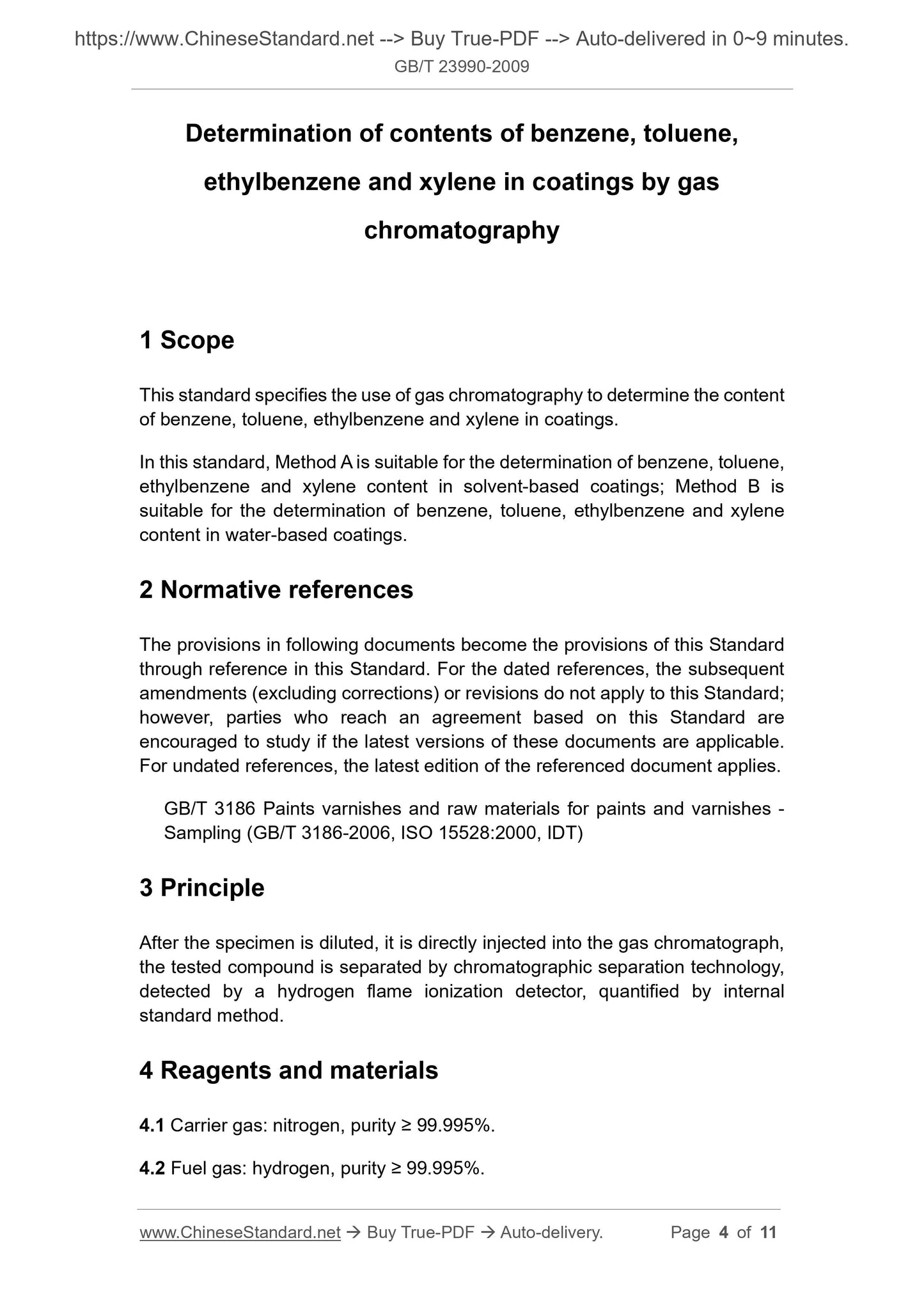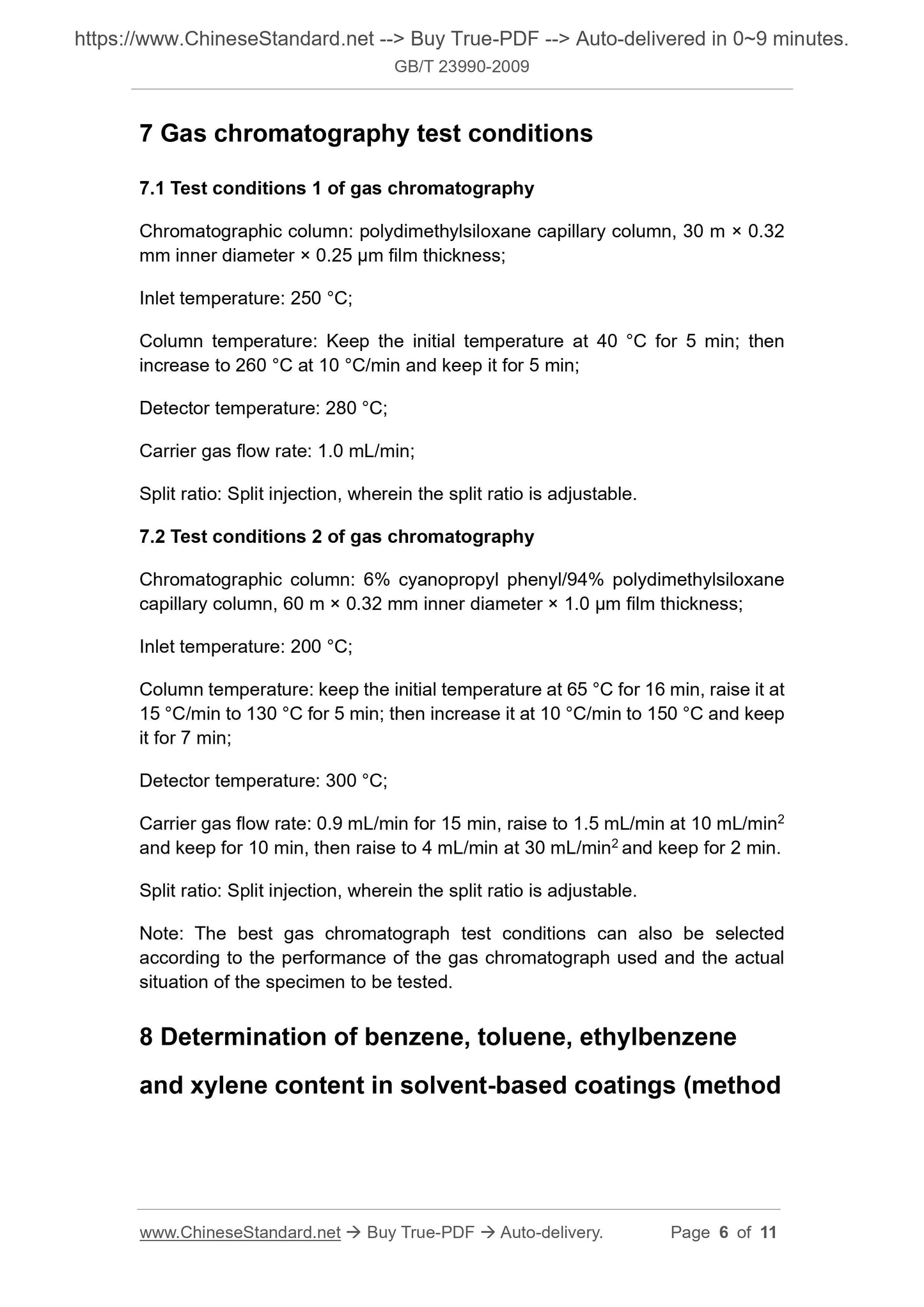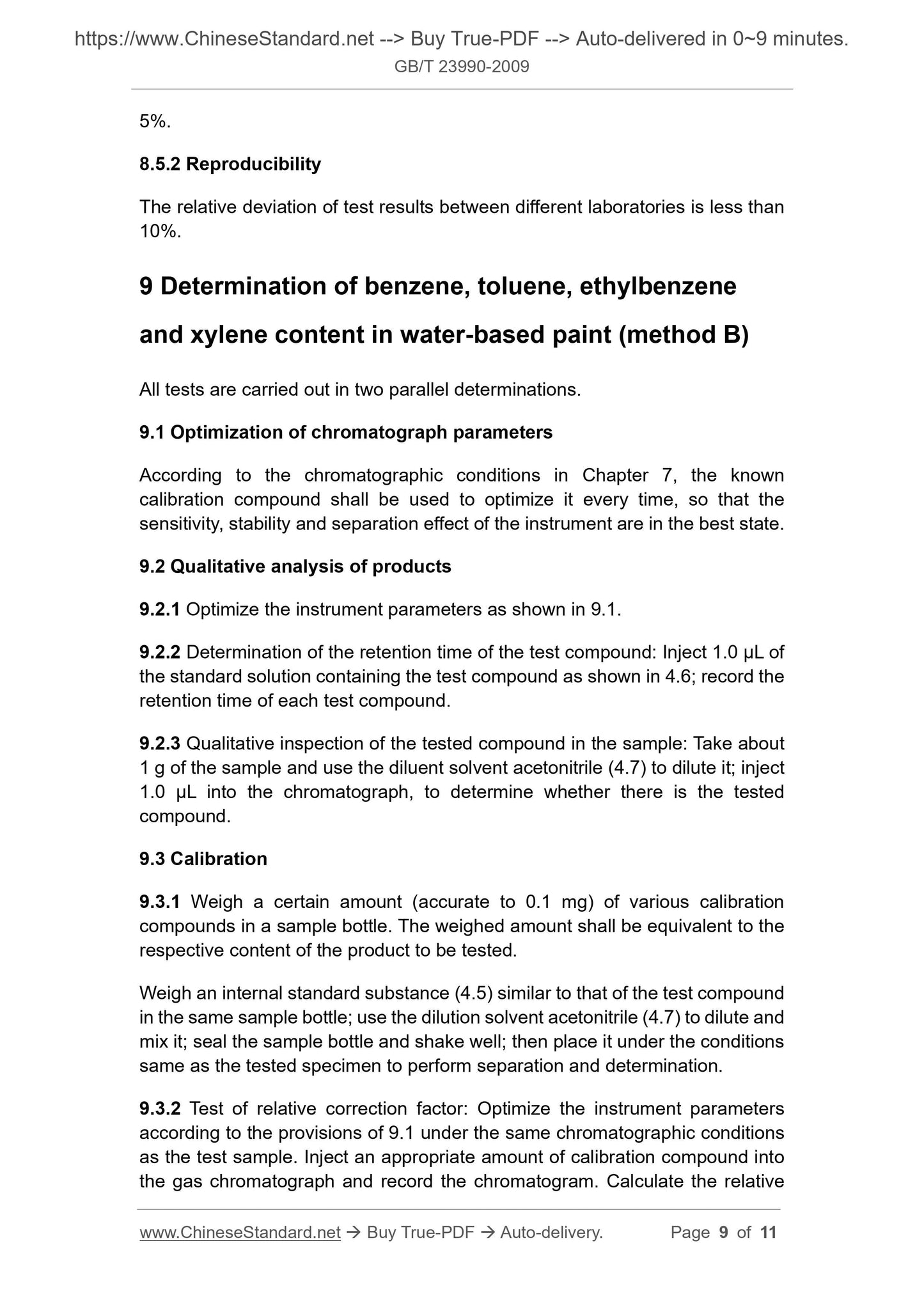1
/
of
5
www.ChineseStandard.us -- Field Test Asia Pte. Ltd.
GB/T 23990-2009 English PDF (GB/T23990-2009)
GB/T 23990-2009 English PDF (GB/T23990-2009)
Regular price
$190.00
Regular price
Sale price
$190.00
Unit price
/
per
Shipping calculated at checkout.
Couldn't load pickup availability
GB/T 23990-2009: Determination of contents of benzene, toluene, ethylbenzene and xylene in coatings by gas chromatography
Delivery: 9 seconds. Download (& Email) true-PDF + Invoice.
Get Quotation: Click GB/T 23990-2009 (Self-service in 1-minute)
Historical versions (Master-website): GB/T 23990-2009
Preview True-PDF (Reload/Scroll-down if blank)
GB/T 23990-2009
GB
NATIONAL STANDARD OF THE
PEOPLE’S REPUBLIC OF CHINA
ICS 87.040
G 50
Determination of contents of benzene, toluene,
ethylbenzene and xylene in coatings by gas
chromatography
ISSUED ON: JUNE 02, 2009
IMPLEMENTED ON: FEBRUARY 01, 2010
Issued by: General Administration of Quality Supervision, Inspection and
Quarantine of PRC;
Standardization Administration of PRC.
Table of Contents
Foreword ... 3
1 Scope ... 4
2 Normative references ... 4
3 Principle ... 4
4 Reagents and materials ... 4
5 Equipment ... 5
6 Sampling ... 5
7 Gas chromatography test conditions ... 6
8 Determination of benzene, toluene, ethylbenzene and xylene content in
solvent-based coatings (method A) ... 6
9 Determination of benzene, toluene, ethylbenzene and xylene content in
water-based paint (method B) ... 9
10 Test report ... 11
Determination of contents of benzene, toluene,
ethylbenzene and xylene in coatings by gas
chromatography
1 Scope
This standard specifies the use of gas chromatography to determine the content
of benzene, toluene, ethylbenzene and xylene in coatings.
In this standard, Method A is suitable for the determination of benzene, toluene,
ethylbenzene and xylene content in solvent-based coatings; Method B is
suitable for the determination of benzene, toluene, ethylbenzene and xylene
content in water-based coatings.
2 Normative references
The provisions in following documents become the provisions of this Standard
through reference in this Standard. For the dated references, the subsequent
amendments (excluding corrections) or revisions do not apply to this Standard;
however, parties who reach an agreement based on this Standard are
encouraged to study if the latest versions of these documents are applicable.
For undated references, the latest edition of the referenced document applies.
GB/T 3186 Paints varnishes and raw materials for paints and varnishes -
Sampling (GB/T 3186-2006, ISO 15528:2000, IDT)
3 Principle
After the specimen is diluted, it is directly injected into the gas chromatograph,
the tested compound is separated by chromatographic separation technology,
detected by a hydrogen flame ionization detector, quantified by internal
standard method.
4 Reagents and materials
4.1 Carrier gas: nitrogen, purity ≥ 99.995%.
4.2 Fuel gas: hydrogen, purity ≥ 99.995%.
7 Gas chromatography test conditions
7.1 Test conditions 1 of gas chromatography
Chromatographic column: polydimethylsiloxane capillary column, 30 m × 0.32
mm inner diameter × 0.25 μm film thickness;
Inlet temperature: 250 °C;
Column temperature: Keep the initial temperature at 40 °C for 5 min; then
increase to 260 °C at 10 °C/min and keep it for 5 min;
Detector temperature: 280 °C;
Carrier gas flow rate: 1.0 mL/min;
Split ratio: Split injection, wherein the split ratio is adjustable.
7.2 Test conditions 2 of gas chromatography
Chromatographic column: 6% cyanopropyl phenyl/94% polydimethylsiloxane
capillary column, 60 m × 0.32 mm inner diameter × 1.0 μm film thickness;
Inlet temperature: 200 °C;
Column temperature: keep the initial temperature at 65 °C for 16 min, raise it at
15 °C/min to 130 °C for 5 min; then increase it at 10 °C/min to 150 °C and keep
it for 7 min;
Detector temperature: 300 °C;
Carrier gas flow rate: 0.9 mL/min for 15 min, raise to 1.5 mL/min at 10 mL/min2
and keep for 10 min, then raise to 4 mL/min at 30 mL/min2 and keep for 2 min.
Split ratio: Split injection, wherein the split ratio is adjustable.
Note: The best gas chromatograph test conditions can also be selected
according to the performance of the gas chromatograph used and the actual
situation of the specimen to be tested.
8 Determination of benzene, toluene, ethylbenzene
and xylene content in solvent-based coatings (method
5%.
8.5.2 Reproducibility
The relative deviation of test results between different laboratories is less than
10%.
9 Determination of benzene, toluene, ethylbenzene
and xylene content in water-based paint (method B)
All tests are carried out in two parallel determinations.
9.1 Optimization of chromatograph parameters
According to the chromatographic conditions in Chapter 7, the known
calibration compound shall be used to optimize it every time, so that the
sensitivity, stability and separation effect of the instrument are in the best state.
9.2 Qualitative analysis of products
9.2.1 Optimize the instrument parameters as shown in 9.1.
9.2.2 Determination of the retention time of the test compound: Inject 1.0 μL of
the standard solution containing the test compound as shown in 4.6; record the
retention time of each test compound.
9.2.3 Qualitative inspection of the tested compound in the sample: Take about
1 g of the sample and use the diluent solvent acetonitrile (4.7) to dilute it; inject
1.0 μL into the chromatograph, to determine whether there is the tested
compound.
9.3 Calibration
9.3.1 Weigh a certain amount (accurate to 0.1 mg) of various calibration
compounds in a sample bottle. The weighed amount shall be equivalent to the
respective content of the product to be tested.
Weigh an internal standard substance (4.5) similar to that of the test compound
in the same sample bottle; use the dilution solvent acetonitrile (4.7) to dilute and
mix it; seal the sample bottle and shake well; then place it under the conditions
same as the tested specimen to perform separation and determination.
9.3.2 Test of relative correction factor: Optimize the instrument parameters
according to the provisions of 9.1 under the same chromatographic conditions
as the test sample. Inject an appropriate amount of calibration compound into
the gas chromatograph and record the chromatogram. Calculate the relative
GB/T 23990-2009
GB
NATIONAL STANDARD OF THE
PEOPLE’S REPUBLIC OF CHINA
ICS 87.040
G 50
Determination of contents of benzene, toluene,
ethylbenzene and xylene in coatings by gas
chromatography
ISSUED ON: JUNE 02, 2009
IMPLEMENTED ON: FEBRUARY 01, 2010
Issued by: General Administration of Quality Supervision, Inspection and
Quarantine of PRC;
Standardization Administration of PRC.
Table of Contents
Foreword ... 3
1 Scope ... 4
2 Normative references ... 4
3 Principle ... 4
4 Reagents and materials ... 4
5 Equipment ... 5
6 Sampling ... 5
7 Gas chromatography test conditions ... 6
8 Determination of benzene, toluene, ethylbenzene and xylene content in
solvent-based coatings (method A) ... 6
9 Determination of benzene, toluene, ethylbenzene and xylene content in
water-based paint (method B) ... 9
10 Test report ... 11
Determination of contents of benzene, toluene,
ethylbenzene and xylene in coatings by gas
chromatography
1 Scope
This standard specifies the use of gas chromatography to determine the content
of benzene, toluene, ethylbenzene and xylene in coatings.
In this standard, Method A is suitable for the determination of benzene, toluene,
ethylbenzene and xylene content in solvent-based coatings; Method B is
suitable for the determination of benzene, toluene, ethylbenzene and xylene
content in water-based coatings.
2 Normative references
The provisions in following documents become the provisions of this Standard
through reference in this Standard. For the dated references, the subsequent
amendments (excluding corrections) or revisions do not apply to this Standard;
however, parties who reach an agreement based on this Standard are
encouraged to study if the latest versions of these documents are applicable.
For undated references, the latest edition of the referenced document applies.
GB/T 3186 Paints varnishes and raw materials for paints and varnishes -
Sampling (GB/T 3186-2006, ISO 15528:2000, IDT)
3 Principle
After the specimen is diluted, it is directly injected into the gas chromatograph,
the tested compound is separated by chromatographic separation technology,
detected by a hydrogen flame ionization detector, quantified by internal
standard method.
4 Reagents and materials
4.1 Carrier gas: nitrogen, purity ≥ 99.995%.
4.2 Fuel gas: hydrogen, purity ≥ 99.995%.
7 Gas chromatography test conditions
7.1 Test conditions 1 of gas chromatography
Chromatographic column: polydimethylsiloxane capillary column, 30 m × 0.32
mm inner diameter × 0.25 μm film thickness;
Inlet temperature: 250 °C;
Column temperature: Keep the initial temperature at 40 °C for 5 min; then
increase to 260 °C at 10 °C/min and keep it for 5 min;
Detector temperature: 280 °C;
Carrier gas flow rate: 1.0 mL/min;
Split ratio: Split injection, wherein the split ratio is adjustable.
7.2 Test conditions 2 of gas chromatography
Chromatographic column: 6% cyanopropyl phenyl/94% polydimethylsiloxane
capillary column, 60 m × 0.32 mm inner diameter × 1.0 μm film thickness;
Inlet temperature: 200 °C;
Column temperature: keep the initial temperature at 65 °C for 16 min, raise it at
15 °C/min to 130 °C for 5 min; then increase it at 10 °C/min to 150 °C and keep
it for 7 min;
Detector temperature: 300 °C;
Carrier gas flow rate: 0.9 mL/min for 15 min, raise to 1.5 mL/min at 10 mL/min2
and keep for 10 min, then raise to 4 mL/min at 30 mL/min2 and keep for 2 min.
Split ratio: Split injection, wherein the split ratio is adjustable.
Note: The best gas chromatograph test conditions can also be selected
according to the performance of the gas chromatograph used and the actual
situation of the specimen to be tested.
8 Determination of benzene, toluene, ethylbenzene
and xylene content in solvent-based coatings (method
5%.
8.5.2 Reproducibility
The relative deviation of test results between different laboratories is less than
10%.
9 Determination of benzene, toluene, ethylbenzene
and xylene content in water-based paint (method B)
All tests are carried out in two parallel determinations.
9.1 Optimization of chromatograph parameters
According to the chromatographic conditions in Chapter 7, the known
calibration compound shall be used to optimize it every time, so that the
sensitivity, stability and separation effect of the instrument are in the best state.
9.2 Qualitative analysis of products
9.2.1 Optimize the instrument parameters as shown in 9.1.
9.2.2 Determination of the retention time of the test compound: Inject 1.0 μL of
the standard solution containing the test compound as shown in 4.6; record the
retention time of each test compound.
9.2.3 Qualitative inspection of the tested compound in the sample: Take about
1 g of the sample and use the diluent solvent acetonitrile (4.7) to dilute it; inject
1.0 μL into the chromatograph, to determine whether there is the tested
compound.
9.3 Calibration
9.3.1 Weigh a certain amount (accurate to 0.1 mg) of various calibration
compounds in a sample bottle. The weighed amount shall be equivalent to the
respective content of the product to be tested.
Weigh an internal standard substance (4.5) similar to that of the test compound
in the same sample bottle; use the dilution solvent acetonitrile (4.7) to dilute and
mix it; seal the sample bottle and shake well; then place it under the conditions
same as the tested specimen to perform separation and determination.
9.3.2 Test of relative correction factor: Optimize the instrument parameters
according to the provisions of 9.1 under the same chromatographic conditions
as the test sample. Inject an appropriate amount of calibration compound into
the gas chromatograph and record the chromatogram. Calculate the relative
Delivery: 9 seconds. Download (& Email) true-PDF + Invoice.
Get Quotation: Click GB/T 23990-2009 (Self-service in 1-minute)
Historical versions (Master-website): GB/T 23990-2009
Preview True-PDF (Reload/Scroll-down if blank)
GB/T 23990-2009
GB
NATIONAL STANDARD OF THE
PEOPLE’S REPUBLIC OF CHINA
ICS 87.040
G 50
Determination of contents of benzene, toluene,
ethylbenzene and xylene in coatings by gas
chromatography
ISSUED ON: JUNE 02, 2009
IMPLEMENTED ON: FEBRUARY 01, 2010
Issued by: General Administration of Quality Supervision, Inspection and
Quarantine of PRC;
Standardization Administration of PRC.
Table of Contents
Foreword ... 3
1 Scope ... 4
2 Normative references ... 4
3 Principle ... 4
4 Reagents and materials ... 4
5 Equipment ... 5
6 Sampling ... 5
7 Gas chromatography test conditions ... 6
8 Determination of benzene, toluene, ethylbenzene and xylene content in
solvent-based coatings (method A) ... 6
9 Determination of benzene, toluene, ethylbenzene and xylene content in
water-based paint (method B) ... 9
10 Test report ... 11
Determination of contents of benzene, toluene,
ethylbenzene and xylene in coatings by gas
chromatography
1 Scope
This standard specifies the use of gas chromatography to determine the content
of benzene, toluene, ethylbenzene and xylene in coatings.
In this standard, Method A is suitable for the determination of benzene, toluene,
ethylbenzene and xylene content in solvent-based coatings; Method B is
suitable for the determination of benzene, toluene, ethylbenzene and xylene
content in water-based coatings.
2 Normative references
The provisions in following documents become the provisions of this Standard
through reference in this Standard. For the dated references, the subsequent
amendments (excluding corrections) or revisions do not apply to this Standard;
however, parties who reach an agreement based on this Standard are
encouraged to study if the latest versions of these documents are applicable.
For undated references, the latest edition of the referenced document applies.
GB/T 3186 Paints varnishes and raw materials for paints and varnishes -
Sampling (GB/T 3186-2006, ISO 15528:2000, IDT)
3 Principle
After the specimen is diluted, it is directly injected into the gas chromatograph,
the tested compound is separated by chromatographic separation technology,
detected by a hydrogen flame ionization detector, quantified by internal
standard method.
4 Reagents and materials
4.1 Carrier gas: nitrogen, purity ≥ 99.995%.
4.2 Fuel gas: hydrogen, purity ≥ 99.995%.
7 Gas chromatography test conditions
7.1 Test conditions 1 of gas chromatography
Chromatographic column: polydimethylsiloxane capillary column, 30 m × 0.32
mm inner diameter × 0.25 μm film thickness;
Inlet temperature: 250 °C;
Column temperature: Keep the initial temperature at 40 °C for 5 min; then
increase to 260 °C at 10 °C/min and keep it for 5 min;
Detector temperature: 280 °C;
Carrier gas flow rate: 1.0 mL/min;
Split ratio: Split injection, wherein the split ratio is adjustable.
7.2 Test conditions 2 of gas chromatography
Chromatographic column: 6% cyanopropyl phenyl/94% polydimethylsiloxane
capillary column, 60 m × 0.32 mm inner diameter × 1.0 μm film thickness;
Inlet temperature: 200 °C;
Column temperature: keep the initial temperature at 65 °C for 16 min, raise it at
15 °C/min to 130 °C for 5 min; then increase it at 10 °C/min to 150 °C and keep
it for 7 min;
Detector temperature: 300 °C;
Carrier gas flow rate: 0.9 mL/min for 15 min, raise to 1.5 mL/min at 10 mL/min2
and keep for 10 min, then raise to 4 mL/min at 30 mL/min2 and keep for 2 min.
Split ratio: Split injection, wherein the split ratio is adjustable.
Note: The best gas chromatograph test conditions can also be selected
according to the performance of the gas chromatograph used and the actual
situation of the specimen to be tested.
8 Determination of benzene, toluene, ethylbenzene
and xylene content in solvent-based coatings (method
5%.
8.5.2 Reproducibility
The relative deviation of test results between different laboratories is less than
10%.
9 Determination of benzene, toluene, ethylbenzene
and xylene content in water-based paint (method B)
All tests are carried out in two parallel determinations.
9.1 Optimization of chromatograph parameters
According to the chromatographic conditions in Chapter 7, the known
calibration compound shall be used to optimize it every time, so that the
sensitivity, stability and separation effect of the instrument are in the best state.
9.2 Qualitative analysis of products
9.2.1 Optimize the instrument parameters as shown in 9.1.
9.2.2 Determination of the retention time of the test compound: Inject 1.0 μL of
the standard solution containing the test compound as shown in 4.6; record the
retention time of each test compound.
9.2.3 Qualitative inspection of the tested compound in the sample: Take about
1 g of the sample and use the diluent solvent acetonitrile (4.7) to dilute it; inject
1.0 μL into the chromatograph, to determine whether there is the tested
compound.
9.3 Calibration
9.3.1 Weigh a certain amount (accurate to 0.1 mg) of various calibration
compounds in a sample bottle. The weighed amount shall be equivalent to the
respective content of the product to be tested.
Weigh an internal standard substance (4.5) similar to that of the test compound
in the same sample bottle; use the dilution solvent acetonitrile (4.7) to dilute and
mix it; seal the sample bottle and shake well; then place it under the conditions
same as the tested specimen to perform separation and determination.
9.3.2 Test of relative correction factor: Optimize the instrument parameters
according to the provisions of 9.1 under the same chromatographic conditions
as the test sample. Inject an appropriate amount of calibration compound into
the gas chromatograph and record the chromatogram. Calculate the relative
GB/T 23990-2009
GB
NATIONAL STANDARD OF THE
PEOPLE’S REPUBLIC OF CHINA
ICS 87.040
G 50
Determination of contents of benzene, toluene,
ethylbenzene and xylene in coatings by gas
chromatography
ISSUED ON: JUNE 02, 2009
IMPLEMENTED ON: FEBRUARY 01, 2010
Issued by: General Administration of Quality Supervision, Inspection and
Quarantine of PRC;
Standardization Administration of PRC.
Table of Contents
Foreword ... 3
1 Scope ... 4
2 Normative references ... 4
3 Principle ... 4
4 Reagents and materials ... 4
5 Equipment ... 5
6 Sampling ... 5
7 Gas chromatography test conditions ... 6
8 Determination of benzene, toluene, ethylbenzene and xylene content in
solvent-based coatings (method A) ... 6
9 Determination of benzene, toluene, ethylbenzene and xylene content in
water-based paint (method B) ... 9
10 Test report ... 11
Determination of contents of benzene, toluene,
ethylbenzene and xylene in coatings by gas
chromatography
1 Scope
This standard specifies the use of gas chromatography to determine the content
of benzene, toluene, ethylbenzene and xylene in coatings.
In this standard, Method A is suitable for the determination of benzene, toluene,
ethylbenzene and xylene content in solvent-based coatings; Method B is
suitable for the determination of benzene, toluene, ethylbenzene and xylene
content in water-based coatings.
2 Normative references
The provisions in following documents become the provisions of this Standard
through reference in this Standard. For the dated references, the subsequent
amendments (excluding corrections) or revisions do not apply to this Standard;
however, parties who reach an agreement based on this Standard are
encouraged to study if the latest versions of these documents are applicable.
For undated references, the latest edition of the referenced document applies.
GB/T 3186 Paints varnishes and raw materials for paints and varnishes -
Sampling (GB/T 3186-2006, ISO 15528:2000, IDT)
3 Principle
After the specimen is diluted, it is directly injected into the gas chromatograph,
the tested compound is separated by chromatographic separation technology,
detected by a hydrogen flame ionization detector, quantified by internal
standard method.
4 Reagents and materials
4.1 Carrier gas: nitrogen, purity ≥ 99.995%.
4.2 Fuel gas: hydrogen, purity ≥ 99.995%.
7 Gas chromatography test conditions
7.1 Test conditions 1 of gas chromatography
Chromatographic column: polydimethylsiloxane capillary column, 30 m × 0.32
mm inner diameter × 0.25 μm film thickness;
Inlet temperature: 250 °C;
Column temperature: Keep the initial temperature at 40 °C for 5 min; then
increase to 260 °C at 10 °C/min and keep it for 5 min;
Detector temperature: 280 °C;
Carrier gas flow rate: 1.0 mL/min;
Split ratio: Split injection, wherein the split ratio is adjustable.
7.2 Test conditions 2 of gas chromatography
Chromatographic column: 6% cyanopropyl phenyl/94% polydimethylsiloxane
capillary column, 60 m × 0.32 mm inner diameter × 1.0 μm film thickness;
Inlet temperature: 200 °C;
Column temperature: keep the initial temperature at 65 °C for 16 min, raise it at
15 °C/min to 130 °C for 5 min; then increase it at 10 °C/min to 150 °C and keep
it for 7 min;
Detector temperature: 300 °C;
Carrier gas flow rate: 0.9 mL/min for 15 min, raise to 1.5 mL/min at 10 mL/min2
and keep for 10 min, then raise to 4 mL/min at 30 mL/min2 and keep for 2 min.
Split ratio: Split injection, wherein the split ratio is adjustable.
Note: The best gas chromatograph test conditions can also be selected
according to the performance of the gas chromatograph used and the actual
situation of the specimen to be tested.
8 Determination of benzene, toluene, ethylbenzene
and xylene content in solvent-based coatings (method
5%.
8.5.2 Reproducibility
The relative deviation of test results between different laboratories is less than
10%.
9 Determination of benzene, toluene, ethylbenzene
and xylene content in water-based paint (method B)
All tests are carried out in two parallel determinations.
9.1 Optimization of chromatograph parameters
According to the chromatographic conditions in Chapter 7, the known
calibration compound shall be used to optimize it every time, so that the
sensitivity, stability and separation effect of the instrument are in the best state.
9.2 Qualitative analysis of products
9.2.1 Optimize the instrument parameters as shown in 9.1.
9.2.2 Determination of the retention time of the test compound: Inject 1.0 μL of
the standard solution containing the test compound as shown in 4.6; record the
retention time of each test compound.
9.2.3 Qualitative inspection of the tested compound in the sample: Take about
1 g of the sample and use the diluent solvent acetonitrile (4.7) to dilute it; inject
1.0 μL into the chromatograph, to determine whether there is the tested
compound.
9.3 Calibration
9.3.1 Weigh a certain amount (accurate to 0.1 mg) of various calibration
compounds in a sample bottle. The weighed amount shall be equivalent to the
respective content of the product to be tested.
Weigh an internal standard substance (4.5) similar to that of the test compound
in the same sample bottle; use the dilution solvent acetonitrile (4.7) to dilute and
mix it; seal the sample bottle and shake well; then place it under the conditions
same as the tested specimen to perform separation and determination.
9.3.2 Test of relative correction factor: Optimize the instrument parameters
according to the provisions of 9.1 under the same chromatographic conditions
as the test sample. Inject an appropriate amount of calibration compound into
the gas chromatograph and record the chromatogram. Calculate the relative
Share
